A-1.3 Documents, Regulations and Specifications
Before installing any gas-fired appliance, it is important to review all the following information to ensure the installation will conform to the necessary requirements:
- Manufacturer’s specifications
- Applicable codes
- Installation, operation, and service instructions
If there is a discrepancy between the manufacturer’s instructions and the codes — for example, in terms of clearances of vent terminations — the most stringent requirements shall prevail. The authority having jurisdiction (AHJ) can provide guidance in case of conflicting requirements.
Failure to follow the manufacturer’s instructions may result in:
- Fire or explosion hazards
- Personal injury or fatalities
- Operating and service problems
- Equipment damage
Manufacturer’s Specifications
Manufacturer's specification sheets (or datasheets) summarize the performance and other technical characteristics of a product in sufficient detail to enable a tradesperson to integrate the component into a system. Typically, the product manufacturer creates a spec sheet. Figure 1 shows an example of the performance section of a spec sheet for a storage-type gas water heater.
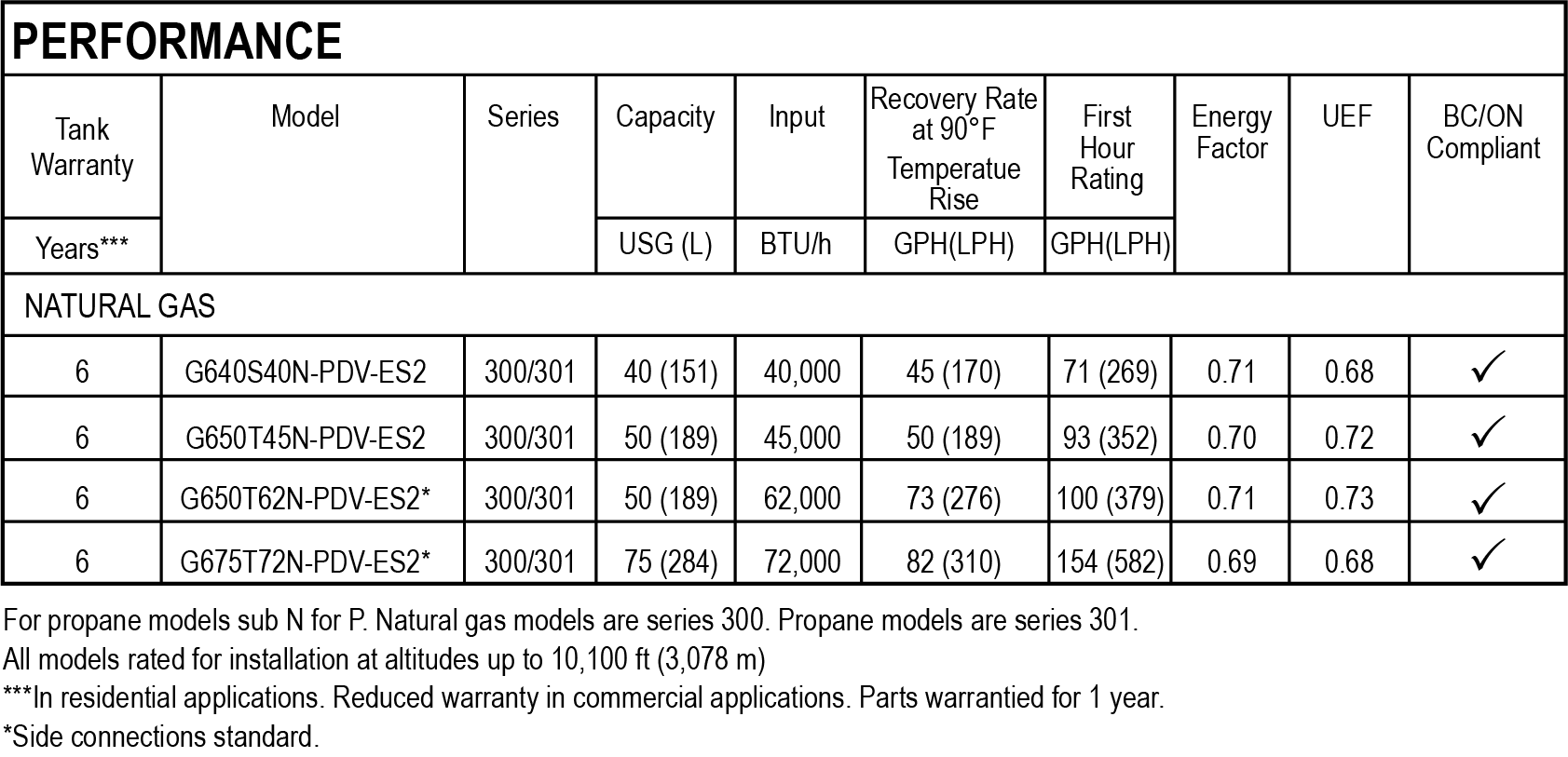
Rating Plates
Notice that the manufacturer’s specifications shown in Figure 1 supplied information regarding more than one model of this product line. To confirm the actual model, an installer will need to check the information found on the rating plate attached to the appliance at the factory. Figure 2 shows two examples of gas hot water boiler rating plates. The boiler on the left is a modern modulating condensing type, and the one on the right is a conventional atmospheric boiler.
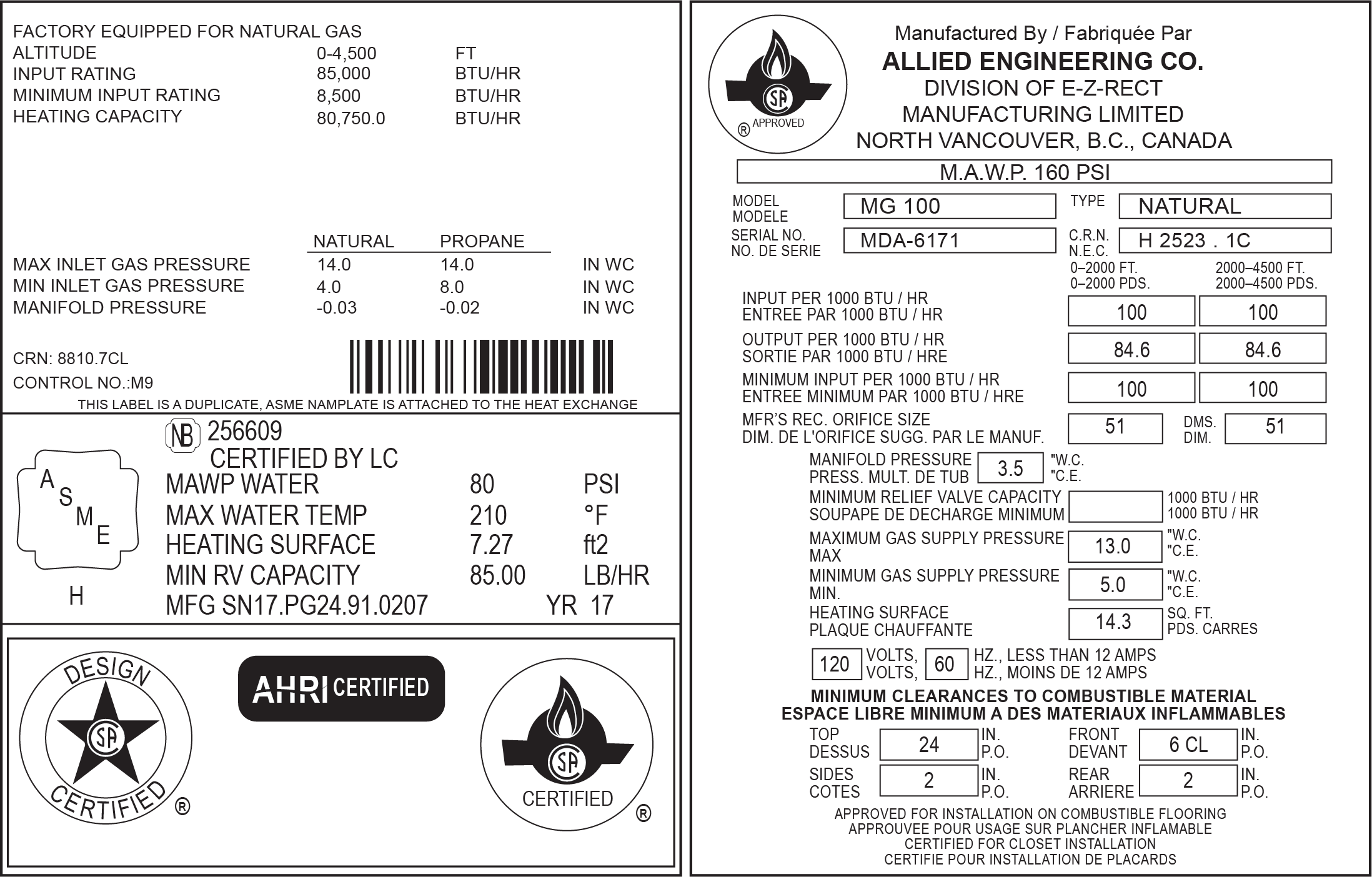
Depending on the type of appliance, some of the common information shown on rating plates include:
- Approvals by regulating authorities and agencies
- Input rating
- Heat output (BTU/h, LPH, LB/h)
- Approved altitude
- Gas supply pressure (minimum and maximum)
- Gas manifold pressure (high fire and low fire)
- Orifice size
- Temperature rise
- Static pressure range (force air furnaces)
- Maximum water pressure (boilers and water heaters)
- Maximum water temperature (boilers and water heaters)
- Minimum relief valve capacity (lb/h steam or BTU/h)
- Appliance clearances
- Operating voltage and current
- Maximum overcurrent protection
- Electric motor HP
Approvals
Gas industry and governmental regulatory agencies must approve all gas appliances before they are sold by the manufacturer. Regulatory authorities recognize the service of third-party certification organizations and demonstrate their approval by insisting that gas appliances be certified by a recognized certification organization.
Certification Organizations
Where a nationally recognized standard exists, the accredited certification organization applies the certification symbol. The official logo, symbol, or seal that indicates the certification of the appliance appears on the appliance’s rating plate. The Standards Council of Canada regulates the certification symbols that must appear on the rating plate of a gas appliance sold in Canada. The table in Figure 3 shows the certification/approval marks that are recognized for gas appliances.
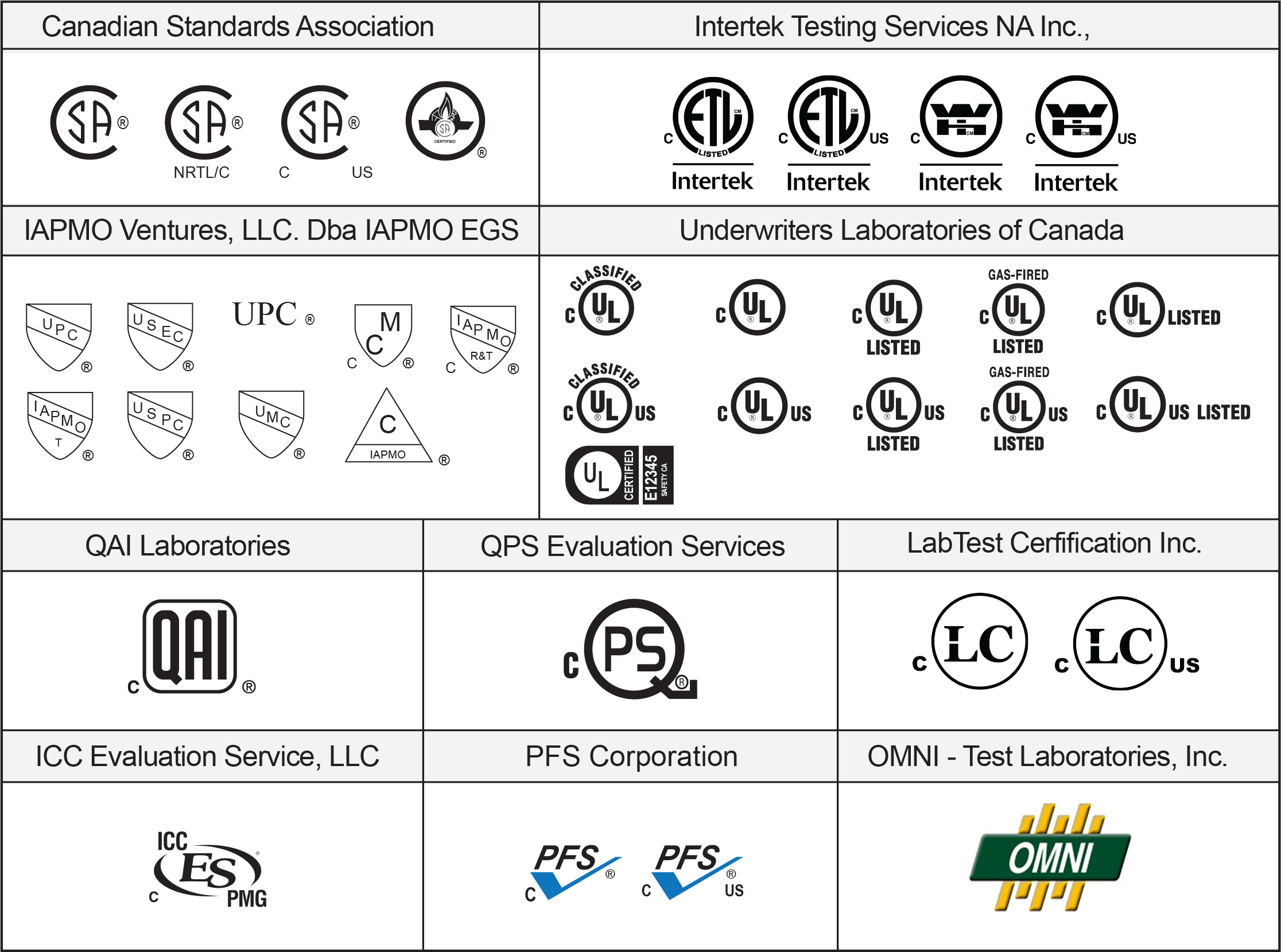
For special gas equipment where a nationally recognized standard does not exist, an inspection body accredited by the Standards Council of Canada is permitted to apply an approval label. This is also known as a “field approval,” and it is void if the appliance is altered or relocated after its original inspection. Figure 4 is an example of a provincial inspection body’s product approval label.
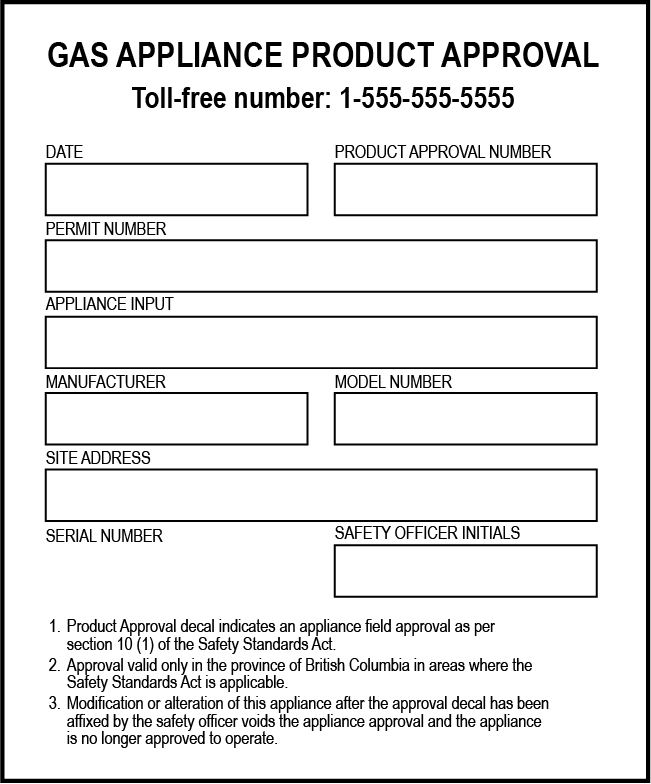
Additionally, boilers and storage water heaters must be designed, constructed, and inspected to the appropriate boiler pressure vessel code and stamped accordingly. The American Society of Mechanical Engineers (ASME) uses various markings to indicate products that they certify. Figure 5 shows some of these approval markings.
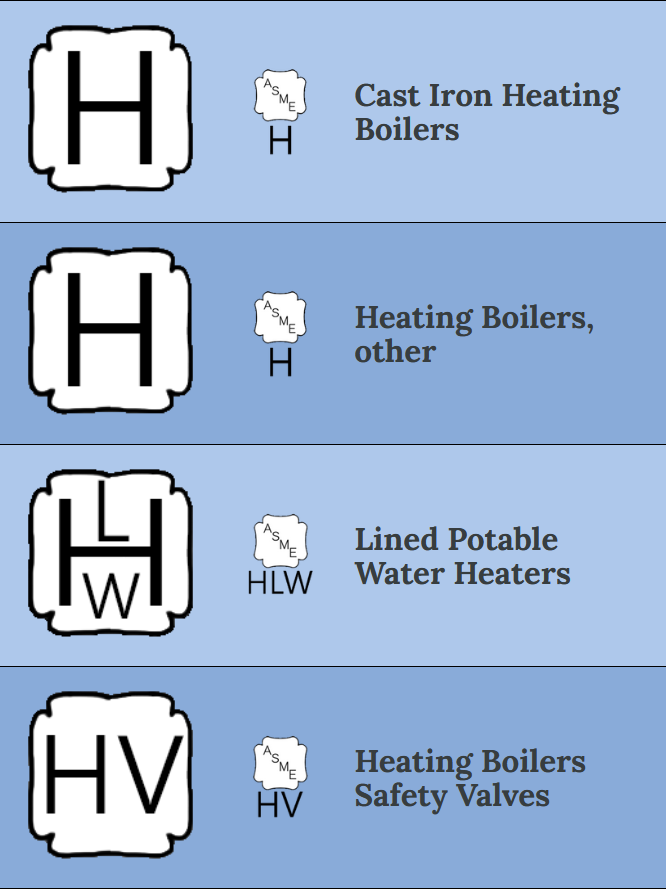
Heat Output
The heat output represents how much of the heat from the combustion process (input energy) is transferred into the product being heated. For a water heater, the output is called the recovery rate, which represents the amount of water that can be heated to a specific temperature every hour. Figure 6 shows two water heater rating plates. The one on the left, from a tankless unit, has a recovery rating of 183.3 GPH, whereas the label on the right, from storage tank type unit, has a recovery rating of 136.72 GPH. Both water heaters could be used for similar load requirements considering that the storage heater has 60 gallons of reserve capacity in the tank.

If a water heater recovery rate needs to be converted to BTU/hr, the installer will need to know the temperature rise that the rating was based on; for example, the gas water heater performance table shown in Figure 1 stipulated that the recovery rate was based on a 90°F temperature rise. The volume referred to is typically US gallons; therefore, the first storage tank in Figure 1 would have a BTU/hr heat of:
[latex]\color{blue}{45\text{ GPH }\times 8.33\text{ lb/US Gallon }\times 90^\circ\text{F}\Delta\text{T}=33\,737\text{ BTU/h}}[/latex]
These manufactures heat output ratings are based on the efficiency of the unit when it is in steady state conditions. Steady state refers to the efficiency of the unit when the system is running continuously, without cycling on and off. This steady state efficiency can be measured by performing a flue gas analysis and concluding the amount of energy being lost into the vent.
Steady state does not give a true measurement of the system’s seasonal efficiency, since it does not account for the cycling or standby losses that take place over the course of the heating season. For example, older gas furnaces may have steady state efficiencies of 78% to 80%, but seasonal efficiencies could be 20% lower, partly due to their standing pilot lights.
Energy Efficiency Standards
Most gas appliances are subject to Canada’s Energy Efficiency Regulations, which set a minimum performance standard for their energy efficiency. The regulation will also identify the Canadian Standards Association (CSA) performance testing procedure. Some provinces also have their own energy efficiency regulations or standards for many federally regulated products.
The accepted benchmark for seasonal efficiencies in heating equipment is the Annual Fuel Utilization Efficiency (AFUE) measure. This rating is influenced by how the furnace is vented, if it has a standing pilot, and its cycling performance.
Separate EnerGuide information appears on manufacturers’ product literature. On the appliance, there is also a separate EnerGuide label or an addition to the rating plate.
For more information, visit the EnerGuide website.
An appliance may have both the black-and-white Canadian EnerGuide label and the black-and-yellow American EnergyGuide. Figure 7 shows examples of these labels.
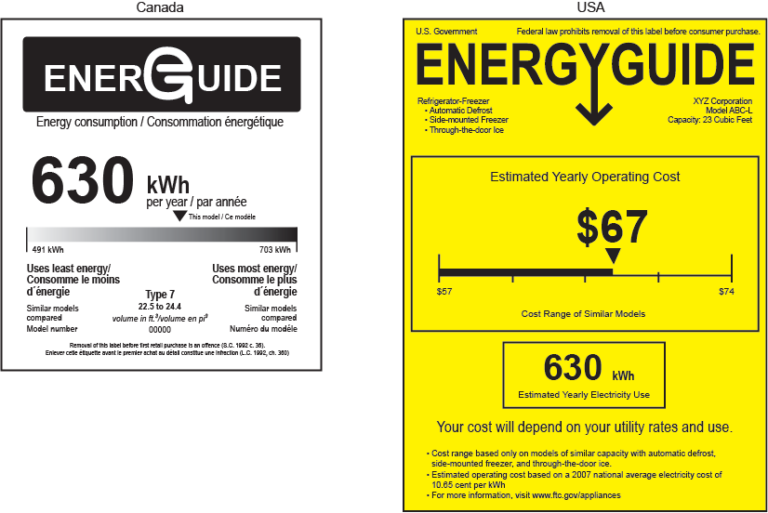
The Canadian EnerGuide information labels display four main items:
- Annual energy consumption of the model in kilowatt hours (kWh)
- An energy consumption indicator, which positions the model compared with the most efficient and least efficient models in the same class
- Type and capacity of models that make up this class
- Appliance model number
ENERGY STAR® Canada is a voluntary partnership between the Government of Canada and industry to make high-efficiency products readily available and visible to Canadians. More than 1,000 businesses and organizations across the country have signed a formal arrangement with Natural Resources Canada (NRCan) to promote energy efficiency in the manufacture, sale, and operation of products and equipment. Participants include manufacturers, retailers, utilities, energy efficiency, environmental advocates, and provincial, territorial, and municipal governments.
The ENERGY STAR symbol (Figure 8) identifies products that have met or exceeded technical specifications for high efficiency.
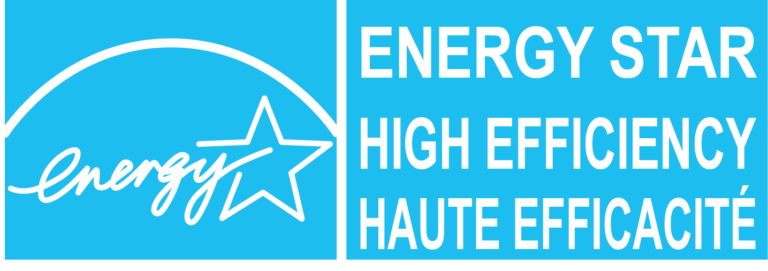
Installation, Operation, and Service Manuals
Most appliances are supplied with manufacturers’ instructions. These provide information on the installation, operation, service, and maintenance requirements.
Information contained in the instruction manual typically includes:
- Safety instructions: for liability reasons, these can be extensive, often including warnings against doing things that no reasonable person would ever consider.
- Assembly instructions: for products that arrive in pieces for easier shipping.
- Component diagrams: for identifications of each component and cross references to numbers for replacement parts.
- Installation instructions: for field installation of the equipment.
- Set-up instructions: for devices that keep track of time or temperature, which maintain a user-accessible state.
- Normal usage instructions.
- Programming instructions: for microprocessor-controlled products, such as boiler control, programmable thermostats, and building automation controllers.
- Wiring diagrams: for identification of field wiring as well as integral component schematics and ladder diagrams for troubleshooting purposes.
- Maintenance instructions.
- Troubleshooting instructions: for when the product does not work as expected.
- Service locations: for when the product requires repair by a factory authorized technician.
- Regulatory code compliance information: for example, with respect to different regional vent termination clearances.
- Product technical specifications.
- Warranty information: sometimes provided as a separate sheet.
Depending on the type of equipment and complexity this information can become too vast for one manual, in which case the information is often compiled into two separated manuals:
- Installation manual: contains detailed installation and operation information.
- Owner’s manual: contains service and maintenance information and basic operating instructions.
Once the equipment is installed, these instructions should be left with the customer for future reference.
Other Installation Requirements
Along with the manufacturer’s certified installation instructions, all installations must also conform to the requirements of applicable building, gas, and electrical codes. Part 7 of the CSA B149.1 outlines specific types of appliances, and Part 4 of the CSA B149.1 contains general requirements. Be sure to consult and review these sections when installing any gas appliance.
Warranty
The standard equipment warranty is a commitment from a manufacturer that a product has no defects at the time of manufacture. Services, such as repairs and partial or complete exchange of defective parts, are guaranteed for a particular period of time.
An extended warranty — sometimes called a service agreement, a service contract, or a maintenance agreement — is a prolonged warranty offered to consumers in addition to the standard warranty on a new item. Extended warranties cost extra, usually a percentage of the item’s retail price.
All products must be properly registered online by the purchaser within a specified period, typically 60 days after the commissioning date, to receive the registered warranty terms. Registration is typically done online and may have to be completed by the certified installer to ensure the appliance was properly installed, operated, and maintained by a licensed professional. To make a warranty claim, the manufacture may request written documentation showing the proper preventive maintenance.
Typically, all damaged parts replaced under warranty must be returned to the manufacturer.
Web Sourcing Manufacturer Documents
All equipment manuals must be left with the customer for future reference on site. However, if the owner misplaces these, they would not be available to the installer for future reference. Fortunately, most manufacturers offer PDF copies of manuals that can be accessed or downloaded from their websites. This has the added advantage of providing convenient access to information for all the current makes and models, as well as archives of discontinued equipment.
Most equipment manufacturers’ websites are set up in a similar format so that the navigation and sourcing of information is quite intuitive. A typical manufacturers’ website has the following menus and features:
- Site search: a search tool that enables the user to enter a term and search the manufacturers’ website for matching results.
- Contact information: may include contacts for technical support, warranty validations, and customer service.
- Dealer locator: with built-in Google Maps integration.
- Products: for searching the entire range of products available; often separated by application, such as residential or commercial.
- Resources: contains a library of downloadable documents for each product, including product brochures, videos, news items, specification sheets, and manuals.
- Emergency call number.
- Warranty: for registering the appliance or filing claims.
- Parts: for searching and ordering replacement parts; typically, electronically searchable with the component serial number.
This web information is often compiled into separate user sections for homeowners, contractors, and engineers. This also enables the manufacturer to limit access to some propriety documents, by requiring contractors or engineers to register with the manufacturer prior to accessing certain information.
 Self-Test A-1.3: Documents, Regulations, and Specifications
Self-Test A-1.3: Documents, Regulations, and Specifications
Complete Self-Test A-1.3 and check your answers.
If you are using a printed copy, please find Self-Test A-1.3 and Answer Key at the end of this section. If you prefer, you can scan the QR code with your digital device to go directly to the interactive Self-Test.
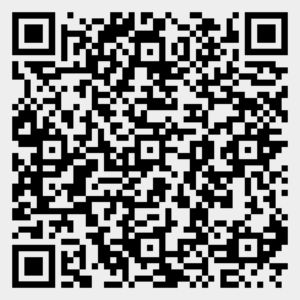
References
Natural Resources Canada. (n.d.). EnerGuide in Canada. Government of Canada. https://natural-resources.canada.ca/energy-efficiency/energuide/12523
[The] EnerGuide label. (2023, December 5). Natural Resources Canada. https://natural-resources.canada.ca/energy-efficiency/energuide/energuide-label/13609
Skilled Trades BC. (2021). Book 1: Fuel gas systems, Heating and cooling systems. Plumber apprenticeship program level 2 book 1 (Harmonized). Crown Publications: King’s Printer for British Columbia.
Spec sheets and manuals. (n.d.). GSW Water Heaters Canada. https://gsw-wh.com/spec-sheets-manuals/
Trades Training BC. (2021). A-1: Introduction to gas-fired appliances. In: Plumber Apprenticeship Program: Level 2. Industry Training Authority, BC.
Media Attributions
All figures are used with permission from Skilled Trades BC (2021) unless otherwise noted.
- Figure 1 Product performance table is originally adapted from Spec Sheets & Manuals – GSW Water Heaters Canada (gsw-wh.com) by Trades Training BC (2021) for educational purposes only.
- Figure 5 ASME Certification Marks are used with permission from ASME to create the compilation shown and cannot be used under the CC BY-NC-SA licence. Boiler and Pressure Vessel Certification.
- Figure 7 Canadian and American energy efficiency labels. (Government of Canada) Non-Commercial Reproduction
- Figure 8 The ENERGY STAR name and symbol are trademarks registered in Canada by the United States Environmental Protection Agency and are administered and promoted by Natural Resources Canada. It is used here with permission.
Long Descriptions
Figure 1 Long Description: Performance Specifications for a Series of Natural Gas Water Heaters
(Skilled Trades BC, 2021/ adapted from original GSW, n.d.) Used with permission.
The following is a detailed description of the Figure 1 table which outlines the performance specifications for a series of natural gas water heaters.
- Model G640S40N-PDV-ES2
- Tank Warranty: 6 years
- Series: 300/301
- Capacity: 40 USG (151 L)
- Input: 40,000 BTU/h
- Recovery Rate: 45 GPH (170 LPH)
- First Hour Rating: 71 GPH (269 LPH)
- Energy Factor: 0.71
- UEF: 0.68
- BC/ON Compliant: Yes (✓)
- Model G650T45N-PDV-ES2
- Tank Warranty: 6 years
- Series: 300/301
- Capacity: 50 USG (189 L)
- Input: 45,000 BTU/h
- Recovery Rate: 50 GPH (189 LPH)
- First Hour Rating: 93 GPH (352 LPH)
- Energy Factor: 0.70
- UEF: 0.72
- BC/ON Compliant: Yes (✓)
- Model G650T62N-PDV-ES2*
- Tank Warranty: 6 years
- Series: 300/301
- Capacity: 50 USG (189 L)
- Input: 62,000 BTU/h
- Recovery Rate: 73 GPH (276 LPH)
- First Hour Rating: 100 GPH (379 LPH)
- Energy Factor: 0.71
- UEF: 0.73
- BC/ON Compliant: Yes (✓)
- Model G675T72N-PDV-ES2*
- Tank Warranty: 6 years
- Series: 300/301
- Capacity: 75 USG (284 L)
- Input: 72,000 BTU/h
- Recovery Rate: 82 GPH (310 LPH)
- First Hour Rating: 154 GPH (582 LPH)
- Energy Factor: 0.69
- UEF: 0.68
- BC/ON Compliant: Yes (✓)
Additional Notes
- For propane models, substitute N for P in the model number. Natural gas models are series 300, while propane models are series 301.
- All models are rated for installation at altitudes up to 10,100 feet (3,078 meters).
- ***In residential applications. Warranty period is reduced for commercial applications. Parts are warrantied for 1 year.
- *Models with side connections as standard.
Figure 2 Long Description: Hot Water Boiler Rating Plate Example
The following is a comprehensive description of the detailed specifications presented on the label for a natural gas appliance manufactured by Allied Engineering Co. This label provides comprehensive information about the appliance, including its operating specifications, pressure ratings, certification details, and installation requirements.
Left Side of the Label
General Information
- Factory Equipped for Natural Gas
- Altitude: 0-4,500 FT
- Input Rating: 85,000 BTU/HR
- Minimum Input Rating: 8,500 BTU/HR
- Heating Capacity: 80,750.0 BTU/HR
Gas Pressure Specifications
- Max Inlet Gas Pressure:
- Natural Gas: 14.0 IN WC
- Propane: 14.0 IN WC
- Min Inlet Gas Pressure:
- Natural Gas: 4.0 IN WC
- Propane: 8.0 IN WC
- Manifold Pressure:
- Natural Gas: -0.03 IN WC
- Propane: -0.02 IN WC
Certification and Additional Information
- CRN: 8810.7CL
- Control No.: M9
- ASME Certification:
- MAWP Water: 80 PSI
- Max Water Temp: 210 °F
- Heating Surface: 7.27 ft²
- Min RV Capacity: 85.00 LB/HR
- Manufacturing Serial No.: SN17.PG24.91.0207
- Year of Manufacture: 17
Right Side of the Label
Manufacturer Information
- Manufactured By: Allied Engineering Co., Division of E-Z-Rect Manufacturing Limited, North Vancouver, B.C., Canada
- Model: MG 100
- Serial No.: MDA-6171
- Type: Natural
- CRN: H 2523 . 1C
- N.E.C.:
- 0–2000 FT: 0–2000 PDS.
- 2000–4500 FT: 2000–4500 PDS.
Input and Output Specifications
- Input per 1000 BTU/HR: 100
- Output per 1000 BTU/HR: 84.6
- Minimum Input per 1000 BTU/HR: 100
- Manufacturer’s Recommended Orifice Size: 51 DMS. DIM.
Pressure and Electrical Specifications
- Manifold Pressure: 3.5 W.C. (Water Column)
- Minimum Relief Valve Capacity: 1000 BTU/HR
- Maximum Gas Supply Pressure: 13.0 W.C. (Water Column)
- Minimum Gas Supply Pressure: 5.0 W.C. (Water Column)
- Heating Surface: 14.3 SQ. FT.
- Electrical Requirements: 120 Volts, 60 HZ., Less Than 12 AMPS
Installation Specifications
- Minimum Clearances to Combustible Material:
- Top: 24 IN.
- Sides: 2 IN.
- Front: 6 IN.
- Rear: 2 IN.
- Approved for Installation on Combustible Flooring
Certifications
- Certified by LC
- AHRI Certified
- Design Certified
Figure 3 Long Description: Accredited Certification Body Marks
This image showcases various certification marks from different organizations that test and certify products for safety and compliance standards.
Canadian Standards Association (CSA)
- CSA: A standard CSA certification mark.
- CSA NRTL/C: Indicates certification by CSA’s Nationally Recognized Testing Laboratory (NRTL) for Canada and the United States.
- CSA C US: Certification by CSA for both Canada and the United States.
- CSA Flame: Indicates a product has been certified for safety in gas-fired applications.
Intertek Testing Services NA Inc.
- ETL C: Intertek’s ETL mark indicating compliance with Canadian standards.
- ETL C US: Intertek’s ETL mark indicating compliance with both Canadian and U.S. standards.
- ETL: Standard ETL mark.
- Intertek Flame C: Intertek’s mark indicating compliance with Canadian standards for gas-fired products.
- Intertek Flame C US: Intertek’s mark indicating compliance with both Canadian and U.S. standards for gas-fired products.
IAPMO Ventures, LLC. Dba IAPMO EGS
- UPC: Uniform Plumbing Code certification mark.
- USEC: Uniform Solar Energy Code certification mark.
- USPC: Uniform Swimming Pool, Spa, and Hot Tub Code certification mark.
- UMC: Uniform Mechanical Code certification mark.
- M C: Certification mark indicating compliance with mechanical standards.
- IAPMO R&T C: Certification mark indicating compliance with IAPMO’s research and testing standards.
- IAPMO Triangle C: IAPMO’s certification mark for various standards.
Underwriters Laboratories of Canada (ULC)
- UL Classified C US: Indicates a product classified by UL for both Canadian and U.S. standards.
- UL Classified C: Indicates a product classified by UL for Canadian standards.
- UL C US: UL’s certification mark for both Canadian and U.S. standards.
- UL Listed Gas-Fired C US: Indicates UL listing for gas-fired products meeting both Canadian and U.S. standards.
- UL Listed Gas-Fired C: Indicates UL listing for gas-fired products meeting Canadian standards.
- UL Certified: Standard UL certification mark.
QAI Laboratories
- QAI C: QAI Laboratories certification mark indicating compliance with Canadian standards.
QPS Evaluation Services
- QPS C: Certification mark indicating compliance with Canadian standards.
LabTest Certification Inc.
- LC C: LabTest Certification mark indicating compliance with Canadian standards.
- LC C US: LabTest Certification mark indicating compliance with both Canadian and U.S. standards.
ICC Evaluation Service, LLC
- ICC ES C: Certification mark indicating compliance with Canadian standards for plumbing, mechanical, and fuel gas products.
PFS Corporation
- PFS C: PFS Corporation certification mark indicating compliance with Canadian standards.
- PFS C US: PFS Corporation certification mark indicating compliance with both Canadian and U.S. standards.
OMNI – Test Laboratories, Inc.
- OMNI: Certification mark indicating compliance with safety and performance standards.
These marks indicate that the products have been tested and certified for safety, performance, and compliance with relevant standards in Canada and the United States.
Figure 4 Long Description: Gas Appliance Field Approval Decal.
(Skilled Trades BC, 2021) Used with permission.
Gas Appliance Product Approval Label
- Header: “GAS APPLIANCE PRODUCT APPROVAL” with a toll-free number: 1-555-555-5555.
- Fields to Fill:
- Date
- Permit Number
- Product Approval Number
- Applicant
- Appliance Input
- Manufacturer
- Model Number
- Serial Number
- Site Address
- Safety Officer Initials
- Approval Information:
- Indicates appliance field approval as per section 10 (1) of the Safety Standards Act.
- Valid only in British Columbia after the approval decal is affixed by a safety officer.
- Modification or alteration voids the approval and the appliance is no longer approved to operate.
This label ensures that gas appliances meet safety standards before operation.
Figure 5 Long Description: Sample Certification Stamps by from the American Society of Mechanical Engineers
Image modified from ASME (n.d.). Used with permission.
The image shows four symbols used in plumbing and HVAC systems to represent different types of heating equipment.
- Top Left: A capital ‘H’ for Cast Iron Heating Boilers.
- Top Right: An ‘H’ with a smaller ‘H’ in the corner for Other Heating Boilers.
- Bottom Left: An ‘H’ with a ‘W’ below it for Lined Water Heaters.
- Bottom Right: An ‘HV’ for Safety Valves.
Figure 6 Long Description: Water Heater Rating Plates
([modified] Skilled Trades BC, 2021) Used with permission.
The image shows a detailed label from a Rinnai Corporation direct vent tankless water heater. The label is divided into two sections, with information in both English and French.
- Left Side:
- Title: Direct-Vent Automatic Instantaneous Water Heater
- Model Number: V2532W
- Serial Number: 03.1004.0159
- Gas Type: Natural Gas
- Electrical Rating: 120V, 60Hz
- Manufacturer: Rinnai Corporation, Nagoya, Japan
- Right Side:
- Barcode and Product Information:
- BTU/hr Ratings: 180,000 BTU/H (maximum), 10,300 BTU/H (minimum)
- Gas Pressures: Maximum Inlet Gas Pressure: 10.5″ W.C., Minimum Inlet Gas Pressure: 5.0″ W.C.
- Water Pressure: Maximum: 150 PSI
- Temperature Settings: Various settings for different functions
- Manufacturing Details: Made in Japan, Manufacturer’s address in Peachtree City, GA
- Barcode and Product Information:
Instructions or details provided by the maker of a product, explaining how the product should be used, installed, and maintained. (Section A-1.3)
A metal or plastic tag on an appliance that shows important details, like how much power it uses, how to install it safely, and any safety standards it meets.(Section A-1.3)
Groups that check if products are made and work safely and correctly. They put special labels on products to show they meet safety rules. Accredited certification organizations apply a special certification symbol. (Section A-1.3)
The amount of heat a machine or appliance, like a water heater, can produce. It shows how much energy it transfers to heat things up. (Section A-1.3)
Rules that set the minimum level of energy use for appliances, making sure they use energy in a smart way and help save power. (Section A-1.3)
A Canadian program that identifies products meeting high-efficiency standards for energy use, helping consumers choose energy-saving appliances. (Section A-1.3)
A guarantee from the manufacturer that a product will be free from defects for a certain period, with free repairs or replacements offered if needed. (Section A-1.3)

